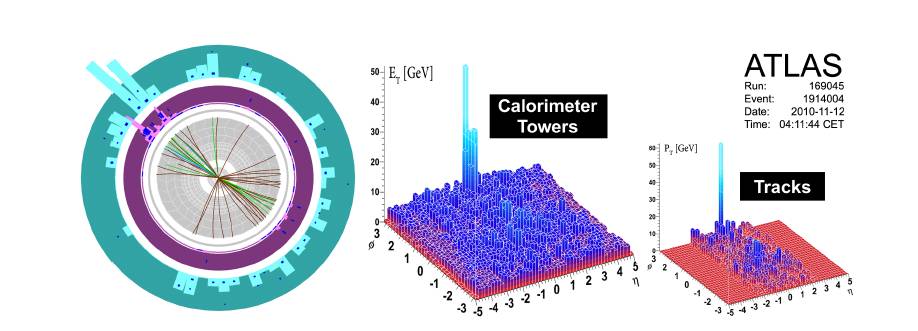Monomania
The ATLAS Collaboration released its first result from Pb+Pb collisions at the LHC, and it’s a blockbuster. Their new paper, titled Observation of a Centrality-Dependent Dijet Asymmetry in Lead-Lead Collisions at √sNN = 2.76 TeV with the ATLAS Detector at the LHC, has been fast-tracked for acceptance in Physical Review Letters. In this paper ATLAS reports the observation of strong quenching in highly energetic jets (> 100 GeV) produced in Pb+Pb collisions at the LHC. The quenching is sufficiently strong that the trigger jet may properly be referred to as a monojet.

The effect is clearly seen in Figure 1 of their paper, reproduced above. The high pT towers that dominate the Lego plot and the event display are unbalanced by a partner jet on the away side in azimuth. Instead, their appears to be enhanced low p emission over nearly the entire away side azimuthal distribution, mostly clearly seen in the towers of the beams-eye view event display.
A more quantitative analysis is of course provided in the paper, in which the evolution of the quenching is presented as a function of centrality, and also compared to HIJING events supplemented with unquenched jets from PYTHIA. For peripheral events, both the the energy asymmetry of the away-side jet and the distribution in azimuthal angle is in good agreement with those seen in p+p events and in the HIJING+PYTHIA Monte Carlo events. This is in sharp distinction to the most central Pb+Pb events, where the jet events have a pronounced asymmetry in energy and a significantly broadened angular distribution.
Of course, the disappearance of the away-side “jet” was discovered by the STAR collaboration in data collected during the first full energy RHIC run. But several aspects of the ATLAS result are even more striking: The observed quenching is for true jets, fully reconstructed in heavy ion events with complete and essentially hermetic hadronic calorimetry; the quenching remains to jet energies of (at least) 100 GeV; and the modification of the jet azimuthal energy distribution is clearly observed in the away-size distribution from the trigger jet. These are all firsts in heavy ion physics, and to see them in a Physical Review Letter a few days after the start of heavy ion physics running at the LHC is indeed remarkable.
The ATLAS results is featured in a CERN press release, dated today (26-Nov-10), where it is stated a similar result from CMS will follow shortly. Also posted today is a Symmetry Magazine article on the ATLAS result containing comments by Brian Cole and Peter Steinberg.